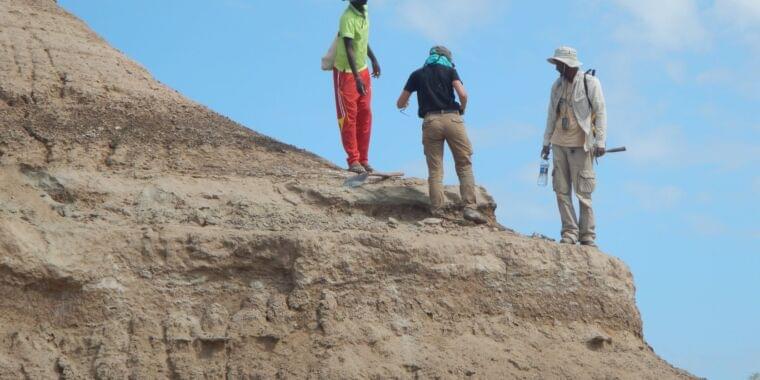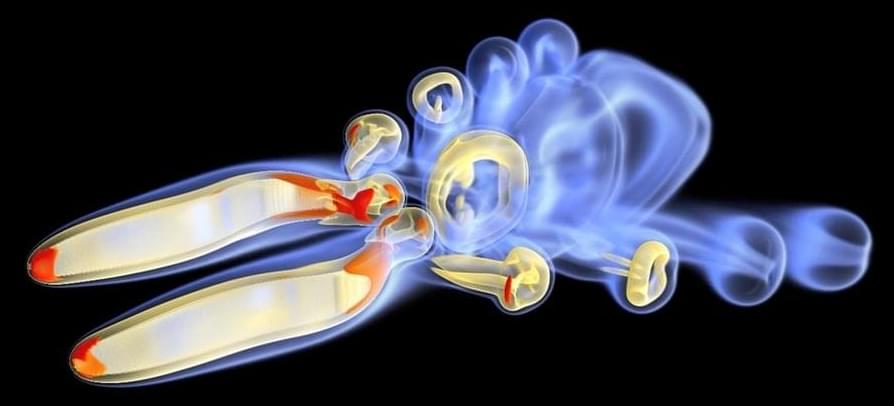Omo I is the oldest skull with clearly Homo sapiens features, including a chin.



Watch out, Matt Murdock — there may be a new Daredevil in Hell’s Kitchen soon enough! While Murdock’s superhero character relies on super hearing, taste and electrical impulses to see because he is blind, IRL folks with low vision may soon have access to a new pair of goggles that uses infrared technology to assist in navigating the world around them.
Manuel Zahn and Armaghan Ahmad Khan at the Technical University of Munich in Germany published yet-to-be peer-reviewed new research on their 3D camera and haptic feedback armband.
“Even in the present era, visually impaired people face a constant challenge of navigation,” the pair wrote in their study. “The most common tool available to them is the cane. Although the cane allows good detection of objects in the user’s immediate vicinity, it lacks the ability to detect obstacles further away.”
10 ROBOT Predictions For 2022 | Boston Dynamics.
🔔 Subscribe now for more Artificial Intelligence news, Data science news, Machine Learning news and more.
🦾 Support us NOW so we can create more videos: https://www.youtube.com/channel/UCItylrp-EOkBwsUT7c_Xkxg.
If you’re anything like us, you probably can’t wait for the day you can go to the store and easily (and cheaply) buy a robot to clean your house, wait on you and do whatever you want. We know that day is a long way off, but technology is getting better all the time. In fact, some high-tech companies have already developed some pretty impressive robots that make us feel like the future is here already.
#Robot #Bostondynamics #futuretechnology.
📺 Fun fact: Smart people watch the entire video!
🤖 AI News Daily provides the latest Artificial Intelligence news and trends. Explore industry research and reports from the frontline of AI technology news.
LEAKED: latest artificial intelligence news | weekly.
🔔 Subscribe now for more Artificial Intelligence news, Data science news, Machine Learning news and more.
🦾 Support us NOW so we can create more videos: https://www.youtube.com/channel/UCItylrp-EOkBwsUT7c_Xkxg.
#ArtificialIntelligence #news #futuretechnology.
📺 Fun fact: Smart people watch the entire video!
Watch More from Artificial Intelligence News Daily.
🟢 Boston Dynamic News: https://youtube.com/playlist?list=PLi7ozibUCGOvQegVXq-ArQSyDcwXqQqls.
🟠 Robot news: https://youtube.com/playlist?list=PLi7ozibUCGOvWDRGAdGxOZx40pjk82hhd.
🔴 Artificial Intelligence News: https://youtube.com/playlist?list=PLi7ozibUCGOuaUErL6-zIj5_R2E7q_cf4
🤖 AI News Daily provides the latest Artificial Intelligence news and trends. Explore industry research and reports from the frontline of AI technology news.
🔔 Subscribe now for more Artificial Intelligence news, Data science news, Machine Learning news and more.
🦾 Support us NOW so we can create more videos: https://www.youtube.com/channel/UCItylrp-EOkBwsUT7c_Xkxg.
From the home to the workplace, and to the sky above, robots in 2022 are transforming the world we know —and helping us understand the worlds we don’t. Let’s highlight a few of these remarkable machines and how they might transform not only how we interact with ourselves, but also the universe around us. We will take about the following robots: Mars Perseverance & Ingenuity, Moley the Robotic Chef, Toyota’s Robotic Butler, Spot by Boston Dynamics, Digit by Agility Robotics, Atlas by Boston Dynamics, Guardian XO Exoskeleton, Vicarious Medical Robot, British loyal wingman and Xenobots!
#robot #robotics #bostondynamics.
📺 Fun fact: Smart people watch the entire video!
🤖 AI News Daily provides the latest Artificial Intelligence news and trends. Explore industry research and reports from the frontline of AI technology news.
Major brands are also getting into the NFT mix, including Dolce & Gabbana, Coca-Cola, Adidas, and Nike. In the future, when you buy a physical world item from a company, you might also gain ownership of a linked NFT in the metaverse.
For example, when you buy that coveted name-brand outfit to wear to the real-world dance club, you might also become the owner of the crypto version of the outfit that your avatar can wear to the virtual Ariana Grande concert. And just as you could sell the physical outfit secondhand, you could also sell the NFT version for someone else’s avatar to wear.
These are a few of the many ways that metaverse business models will likely overlap with the physical world. Such examples will get more complex as augmented reality technologies increasingly come into play, further merging aspects of the metaverse and physical world. Although the metaverse proper isn’t here yet, technological foundations like blockchain and crypto assets are steadily being developed, setting the stage for a seemingly ubiquitous virtual future that is coming soon to a ‘verse near you.
Peter Diamandis, Chairman and Co-Founder of Singularity University, discusses the best way to predict the future, and shares his personal philosophies on innovation and the commercial space industry. Flimed at Singularity University’s Executive Program, March 2010.
Subscribe: http://bit.ly/1Wq6gwm.
Connect with Singularity University:
Website: http://singularityu.org.
Singularity HUB: http://singularityhub.com.
Facebook: https://www.facebook.com/singularityu.
Twitter: https://twitter.com/singularityu.
Linkedin: https://www.linkedin.com/company/singularity-university.
Google+: https://plus.google.com/+singularityu.
About Singularity University:
Singularity University is a benefit corporation headquartered at NASA’s research campus in Silicon Valley. We provide educational programs, innovative partnerships and a startup accelerator to help individuals, businesses, institutions, investors, NGOs and governments understand cutting-edge technologies, and how to utilize these technologies to positively impact billions of people.
Peter Diamandis — The best way to predict the future | Singularity University.

The firm partnered with Israeli startup Corsight AI to develop the facial recognition cameras to be worn by police officers, Tirza told AFP.
By matching faces to old photographs on its database, the camera developed by Yozmot will be able to instantly identify people in a crowd, even if they are wearing camouflage, make-up or masks.
Corsight refused to confirm the collaboration with Yozmot, according to AFP, but has said that it was working with some 230 “integrators” worldwide who incorporated facial recognition software into cameras.
IRENA says green hydrogen could disrupt global trade and bilateral energy relations, reshaping the positioning of states with new hydrogen exporters and users emerging.

There are few environments as unforgiving as the ocean. Its unpredictable weather patterns and limitations in terms of communications have left large swaths of the ocean unexplored and shrouded in mystery.
“The ocean is a fascinating environment with a number of current challenges like microplastics, algae blooms, coral bleaching, and rising temperatures,” says Wim van Rees, the ABS Career Development Professor at MIT. “At the same time, the ocean holds countless opportunities — from aquaculture to energy harvesting and exploring the many ocean creatures we haven’t discovered yet.”
Ocean engineers and mechanical engineers, like van Rees, are using advances in scientific computing to address the ocean’s many challenges, and seize its opportunities. These researchers are developing technologies to better understand our oceans, and how both organisms and human-made vehicles can move within them, from the micro scale to the macro scale.